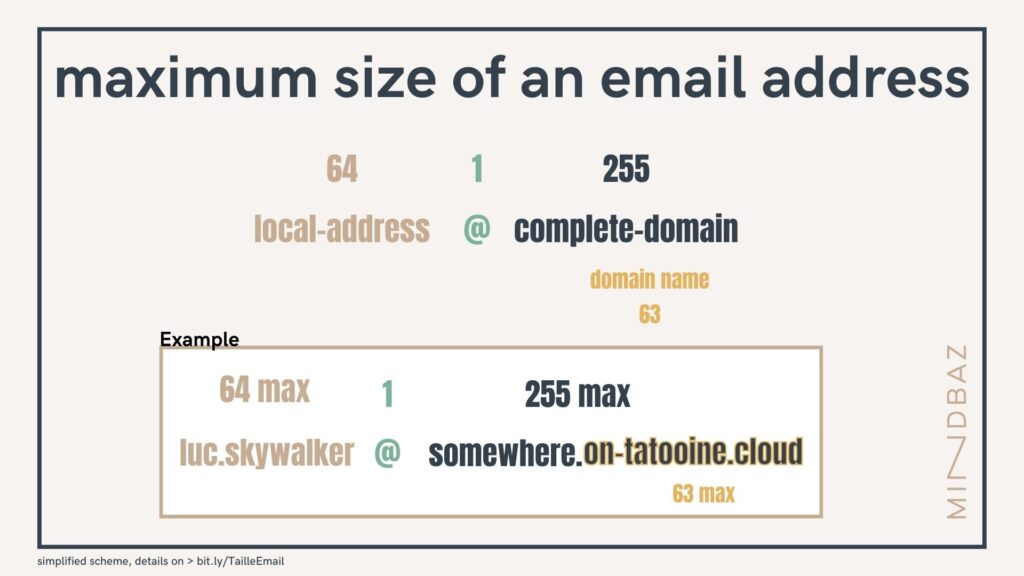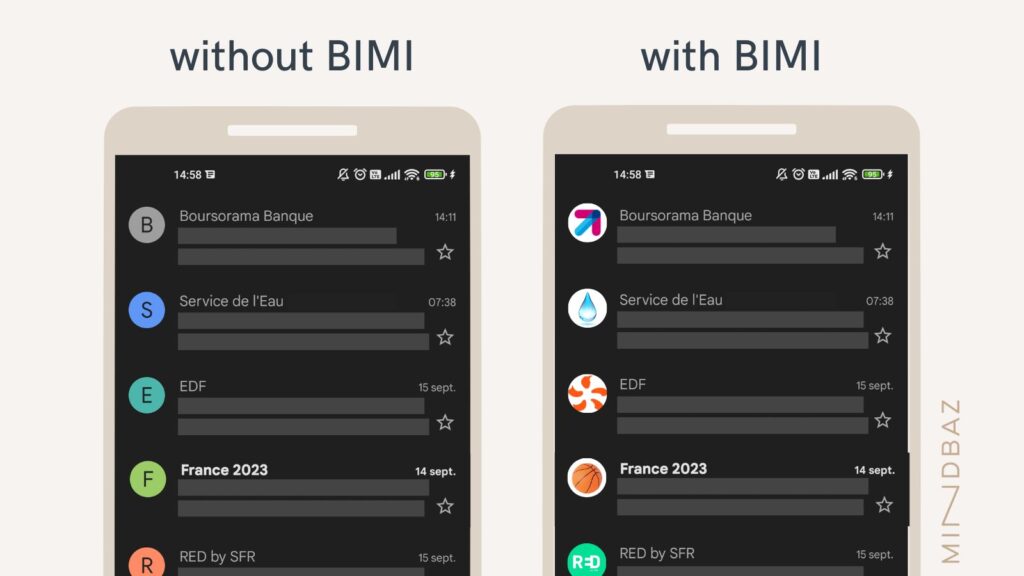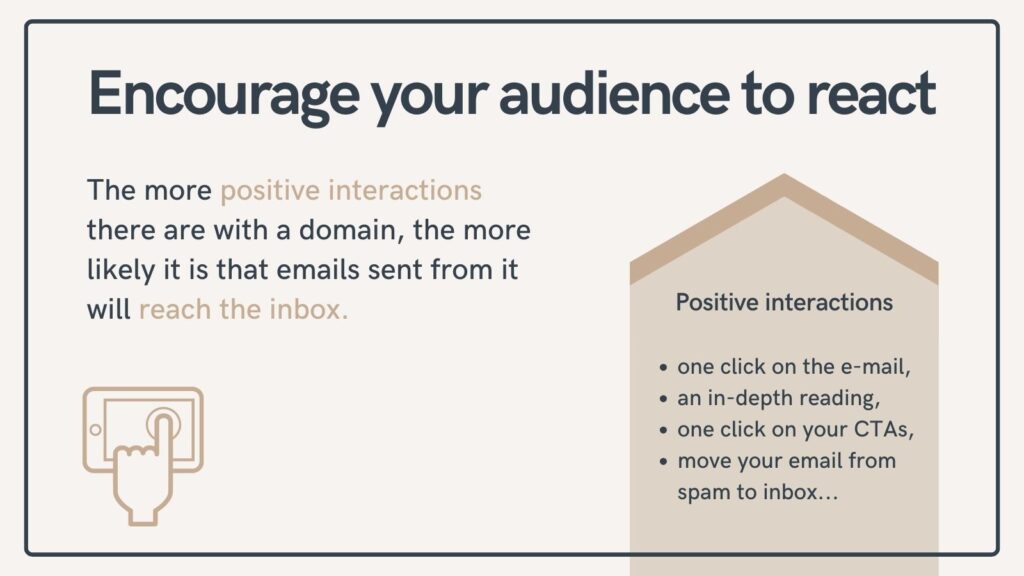- Generic email and deliverability terms
- Specific vocabulary used by email marketing and communications experts
- Technical email glossary
Email and deliverability : definitions and examples
A/B Testing
An AB Testing campaign allows you to test one of your campaign’s attributes:- subject line
- sender
- content (title, tagline, etc.)
- call-to-action (CTA) button.
Email address
The email address is a unique address that allows people to be contacted online. It is regulated by rules that restrict its naming. What are the rules for creating an email address?
What are the rules for creating an email address?Apple Mail Privacy Protection (Apple MPP)
In the Mail app, the Mail Privacy Protection feature prevents senders from using web beacons to collect information about users. This feature enables users to prevent senders from knowing when they open an email. In addition, Apple Mail Privacy Protection allows IP addresses to be masked.Read our full article on Apple Mail Privacy Protection
BIMI
BIMI stands for “Brand Indicators for Message Identification”. It’s a new standard that makes it easier to identify the sender of an e-mail. BIMI is linked to the sender. If a brand has a BIMI registration, it enjoys several benefits from Mailbox Service Providers who have implemented BIMI:- Display its logo in mailboxes supporting BIMI
- Immediate email sender identification
- For users, it’s an additional security feature

Read our article: Mailbox Services Providers make it easy to identify issuers with BIMI
Inactive contact
An inactive contact is a contact that does not interact or no longer interacts with sent content. A contact can be inactive in different ways:- Inactive addresses: These contacts have never interacted with your e-mails since signing up.
- Formerly active contacts: These contacts used to open and click on your e-mails, but no longer do so.
Deliverability
Email deliverability refers to the ability of a message or campaign to reach its recipients in their primary or secondary inboxes (e.g. Google’s promotion tab).Display Name
The sender name, or Display Name, is the name that appears in your recipient’s mailbox instead of your sender email. By following the best practices of MSPs and filters, the formatting of this Display Name will have a positive impact on your deliverability.Click here to read our article Display Name: How to choose the best sender name for your emailing campaign?
Disposable Email
It’s an email address that allows you to receive emails at a temporary address. The email address is self-destructing or reset after a given period of time. These services, created for private individuals, make it possible to avoid giving out a personal email address and therefore receiving spam. Some disposable email creation services give access to the inbox linked to the email address during its lifetime. This feature is helpful for validating confirmation emails when creating an account. In France, two well-known temporary e-mail services are yopmail and temp-mail.Hard bounce
A hard bounce is a hard error message returned by the Mailbox Service Provider. It indicates that the requested user does not exist (or no longer exists) due to an invalid or outdated e-mail address. Hard bounce examples: camille@travol.com > domain error firstnameexemple@yahoo.com > address no longer valid.Opt-in
Before you can send communications or advertising by email, text message or MMS, you need to get the recipient’s consent. A recipient is said to be opt-in if they have agreed to receive messages from a company. An opt-in database is made up solely of contacts who have given their consent to receive messages.Email router
An email router (or ESP) allows you to manage the sending of email messages to a large list of recipients. Most email routers include in their services:- SPF and DKIM declaration management
- IPS preheating
- An interface for monitoring statistics and adapting email lists.
Soft bounces
A soft bounce is a temporary error message. Examples include:- a full mailbox
- unavailable recipient server
- message is too large
Spam
Spam is an unsolicited message from a bulk e-mail campaign. Spam is often sent by:- text messages
- social networks
- phone calls
Spambounce
A spambounce is an alert. Your message has been identified as spam. The recipient has not received the message. For example, rejections due to blacklisting or recipient complaints.Spamtrap
A spamtrap is an e-mail address designed to trap senders who don’t comply with best practices in terms of database collection and management. There are two types of spamtrap:- Inactive spamtrap: an existing but inactive e-mail address used by ISPs to check database compliance.
- Active spamtrap, also known as honeypot: an e-mail address specifically created to trap senders who are stealing or harvesting e-mail from the web.
Filter spamtraps with SafeSend
Spam word
Words or phrases that e-mail service providers (ISPs) identify in your e-mails and increase the risk of your e-mails being placed in the “spam” folder. Today, a spam word will not automatically send your message to the spam folder. Heuristic and Bayesian filters take spam words into account, among other things, to sort emails more efficiently.Discover more than 130 spam words that will help you boost your email deliverability
Glossary to email marketing and communication
Marketing audit
A marketing audit provides an assessment of a company’s marketing strategy, and thus an insight into its strengths and weaknesses. The auditors can offer advice and solutions to improve the efficiency of the company’s marketing actions. This marketing audit can be carried out in-house or by an external service provider.Find out more about our email audit rates
Call to action
Also known as a call-to-action button, it’s a clickable visual element that redirects to another page (an offer, for example). It helps to convert the audience into a lead. The button’s design increases the likelihood of clicking, compared with a hypertext link.
Targeting or segmentation
Email targeting (or segmentation) involves grouping contacts based on one or more criteria. There are several types of criteria:- Socio-demographic criteria: gender, age, job title, etc.
- Behavioral criteria: browsing patterns, time spent, number of visits, etc.
- Psychographic criteria: interests, personality, etc.
- Geographic criteria: location, weather, etc.
Co-registration
Co-registration is a collection method used by one of your partners. The logo, along with an explanatory text, is displayed prominently for web users, for greater transparency. For example, when subscribing to a newsletter on a website, The partner adds a section to the form for another offer.Co-sponsoring
Co-sponsoring involves sponsoring a partner’s fund-raising operation to attract subscribers. The sponsor’s logo often appears at the bottom of the page and in the operation’s legal notices (contests, newsletter registration, etc.).PRM
“Prospect Relationship Management. PRM is the management of the prospect relationship within a company. A prospect is a potential customer. The aim is to create a strategy with the best possible contact gathering, then to transform these contacts into leads and then into customers.RCS
RCS stands for “Rich Communication Services”. Considered by some to be the future of text messaging, RCS is a mobile communications protocol based on 3/4/5G or Wi-Fi. RCS has the same features as apps like Whatsapp or Messenger. It can be native on the smartphone, but can also be downloaded for an alternative version.Read our article RCS v. SMS: What are the differences for your marketing strategy?
Tech Email glossary
API
An API (application programming interface) is a software interface used to “interconnect” software or services in order to exchange data and features.Design System
A Design System is a library of components, visuals and guidelines with reusable code. It’s a toolkit that evolves over time. It provides a UX and UI repository for designers and developers.DKIM
DKIM (Domain Keys Identified Mail) is an authentication technique designed to prevent e-mail address forgery. Its aim is to reinforce e-mail security by enabling the recipient’s mail server to verify the legitimacy of the sender’s domain.Mailbox Service Providers
A Mailbox Service Provider offers a service for sending and receiving emails.
Here are a few MSPs:
- Gmail
- Yahoo!
- Outlook
- AOL Mail
- Zoho Mail
- Mail.Com
- GMX
- ProtonMail
- iCloud Mail
- Mailbox.org
Internet Service Provider (ISP)
An Internet Service Provider (ISP) is an organization offering Internet access using specific technologies.
Internet access can be limited or unlimited, depending on the plan chosen by the customer.
For example, in France:
- SFR
- Orange
- Bouygues Telecom
- Free
In Spain :
- Orange.
- Vodafone
- Lowi
- Movistar
- Yoigo
- Más Móvil
In the United States :
- Verizon
- Comcast
- Time Warner
- AT&T
- Cox
SaaS
SaaS stands for “Software as a Service”. It is a cloud-based service. The service is accessed via a web app or a web browser.
Read more about the philosophy of our saas solutions in Mindbaz
SFTP
SFTP stands for Secure File Transfer Protocol.
The purpose of an SFTP server is to host files using its communication protocol, which ensures secure transfer.
The SFTP protocol provides secure access to a machine by encrypting the data being processed.
SPF
The Sender Policy Framework (SPF) is an e-mail authentication protocol that enables companies to define who is authorized to use their domain to send messages.
SSO
Single sign-on (SSO) is an authentication system that enables a user to access multiple apps without having to enter a password. The user enters a password at the start of the session, and can then access the other apps for which they have access rights.
Webmail
Webmail is an e-mail inbox available online through a browser. Mailbox Service Providers include webmail for viewing and editing messages.
Examples:
- Gmail
- Orange
- Yahoo
- La Poste
- Hotmail


